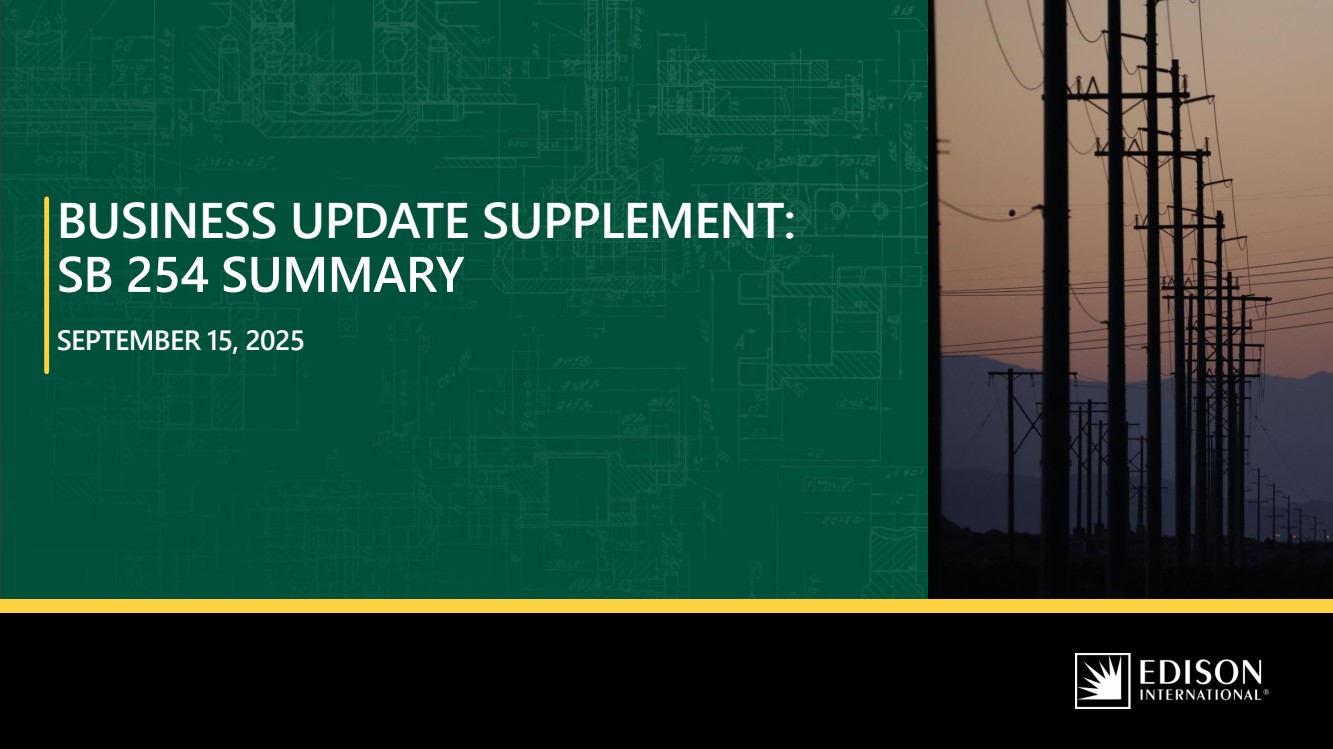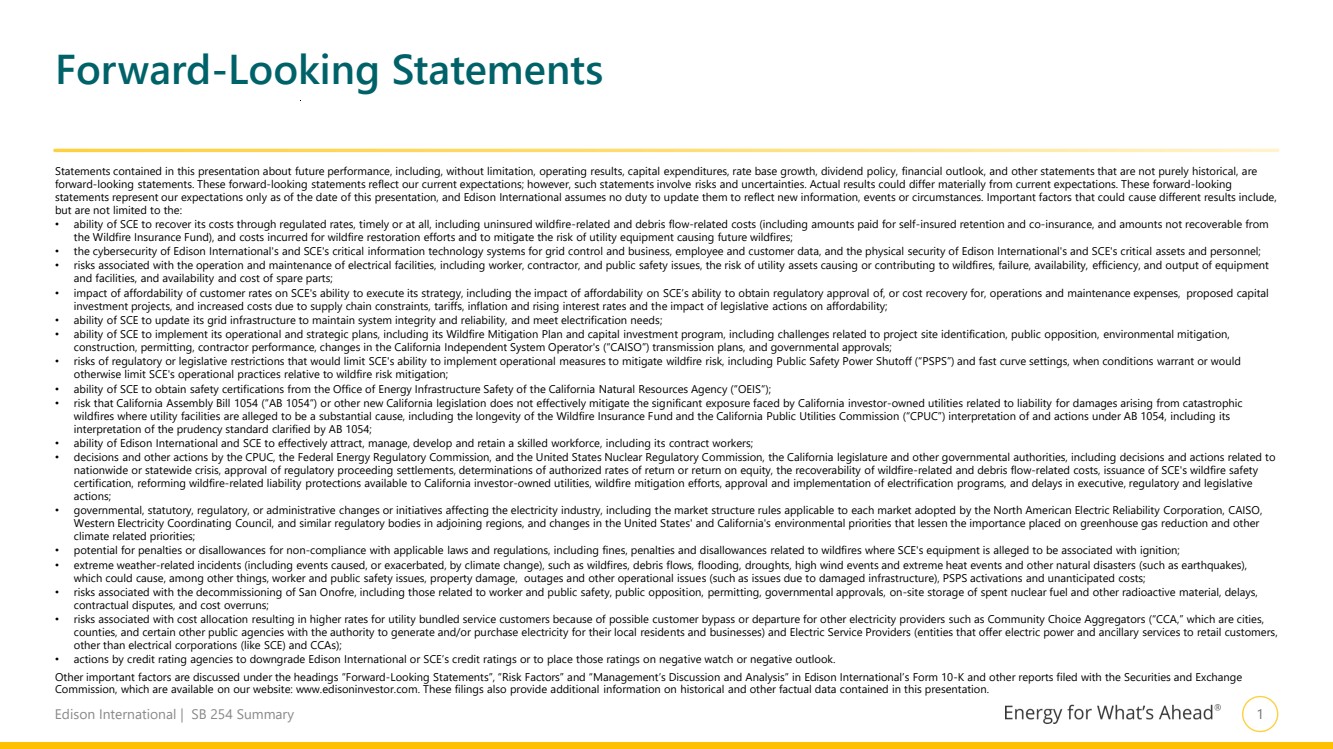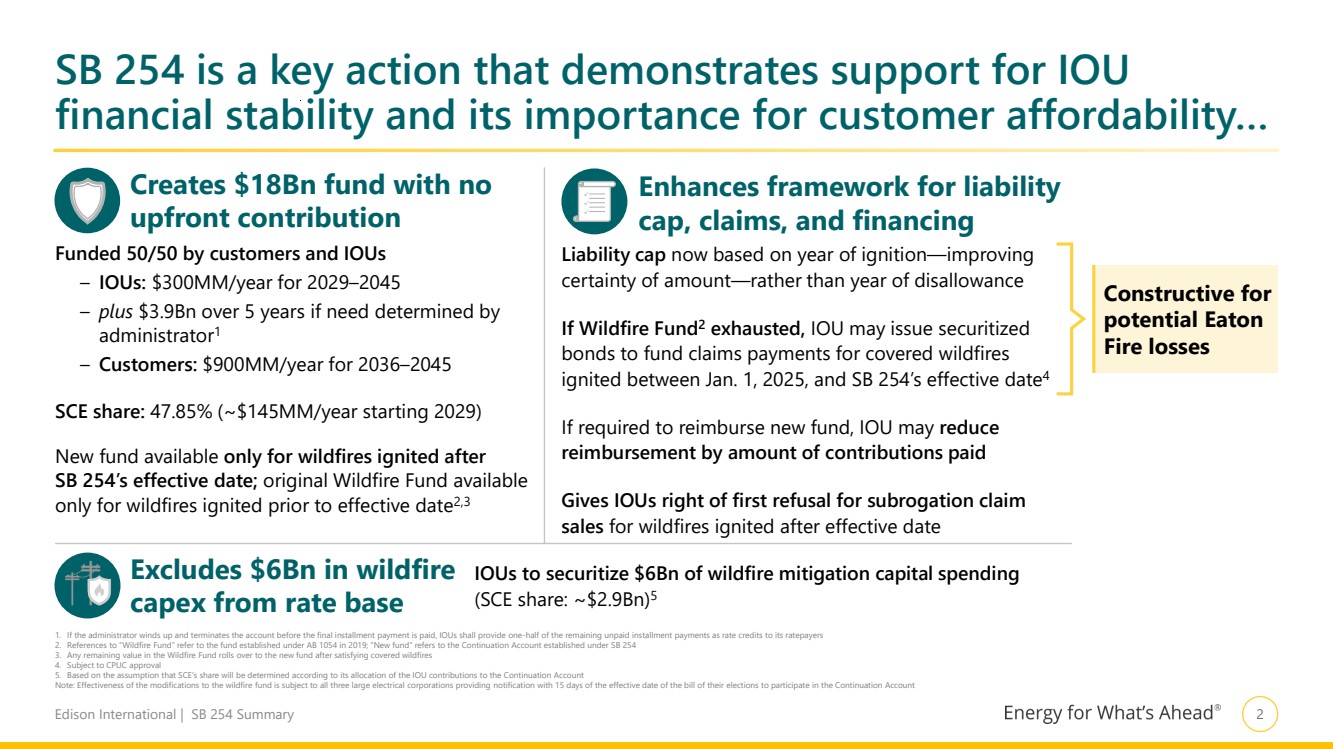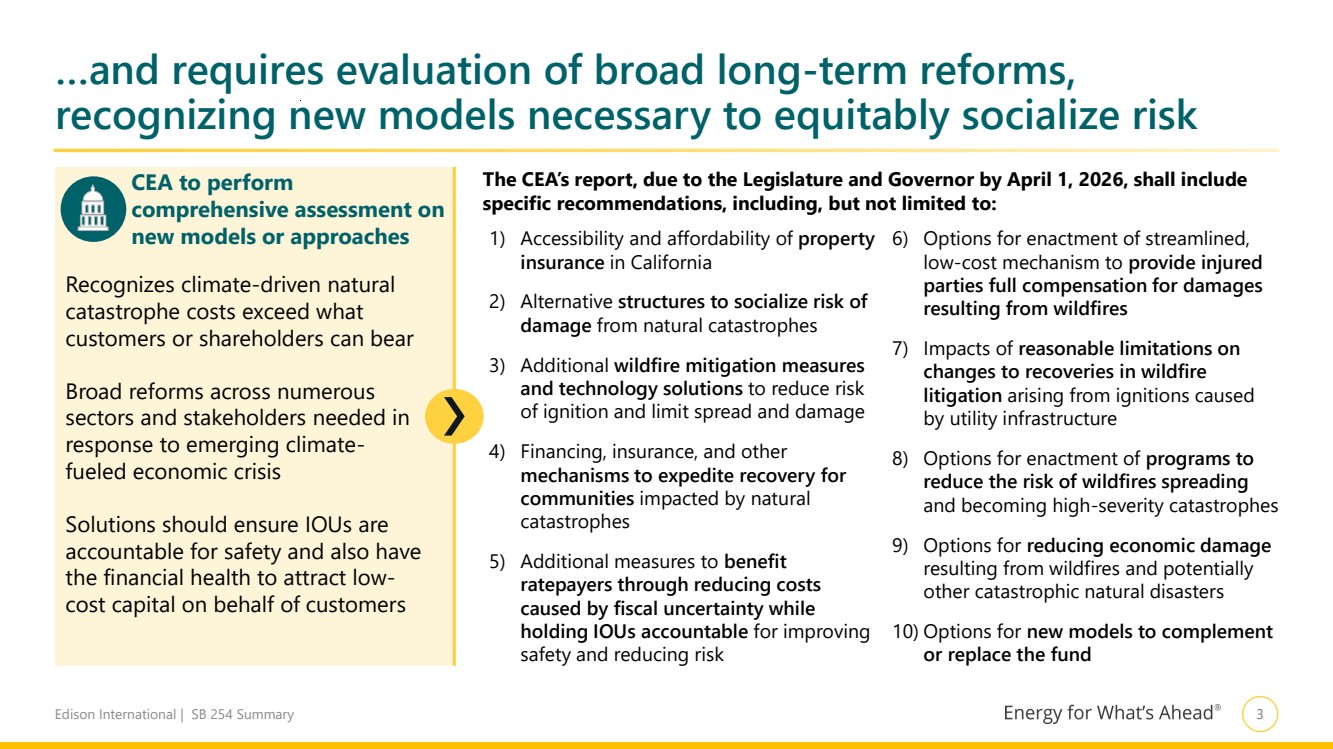| SEPTEMBER 15, 2025 BUSINESS UPDATE SUPPLEMENT: SB 254 SUMMARY |
| Edison International | SB 254 Summary 1 Statements contained in this presentation about future performance, including, without limitation, operating results, capital expenditures, rate base growth, dividend policy, financial outlook, and other statements that are not purely historical, are forward-looking statements. These forward-looking statements reflect our current expectations; however, such statements involve risks and uncertainties. Actual results could differ materially from current expectations. These forward-looking statements represent our expectations only as of the date of this presentation, and Edison International assumes no duty to update them to reflect new information, events or circumstances. Important factors that could cause different results include, but are not limited to the: • ability of SCE to recover its costs through regulated rates, timely or at all, including uninsured wildfire-related and debris flow-related costs (including amounts paid for self-insured retention and co-insurance, and amounts not recoverable from the Wildfire Insurance Fund), and costs incurred for wildfire restoration efforts and to mitigate the risk of utility equipment causing future wildfires; • the cybersecurity of Edison International's and SCE's critical information technology systems for grid control and business, employee and customer data, and the physical security of Edison International's and SCE's critical assets and personnel; • risks associated with the operation and maintenance of electrical facilities, including worker, contractor, and public safety issues, the risk of utility assets causing or contributing to wildfires, failure, availability, efficiency, and output of equipment and facilities, and availability and cost of spare parts; • impact of affordability of customer rates on SCE's ability to execute its strategy, including the impact of affordability on SCE’s ability to obtain regulatory approval of, or cost recovery for, operations and maintenance expenses, proposed capital investment projects, and increased costs due to supply chain constraints, tariffs, inflation and rising interest rates and the impact of legislative actions on affordability; • ability of SCE to update its grid infrastructure to maintain system integrity and reliability, and meet electrification needs; • ability of SCE to implement its operational and strategic plans, including its Wildfire Mitigation Plan and capital investment program, including challenges related to project site identification, public opposition, environmental mitigation, construction, permitting, contractor performance, changes in the California Independent System Operator's (“CAISO”) transmission plans, and governmental approvals; • risks of regulatory or legislative restrictions that would limit SCE's ability to implement operational measures to mitigate wildfire risk, including Public Safety Power Shutoff (“PSPS”) and fast curve settings, when conditions warrant or would otherwise limit SCE's operational practices relative to wildfire risk mitigation; • ability of SCE to obtain safety certifications from the Office of Energy Infrastructure Safety of the California Natural Resources Agency (“OEIS“); • risk that California Assembly Bill 1054 (“AB 1054“) or other new California legislation does not effectively mitigate the significant exposure faced by California investor-owned utilities related to liability for damages arising from catastrophic wildfires where utility facilities are alleged to be a substantial cause, including the longevity of the Wildfire Insurance Fund and the California Public Utilities Commission (“CPUC”) interpretation of and actions under AB 1054, including its interpretation of the prudency standard clarified by AB 1054; • ability of Edison International and SCE to effectively attract, manage, develop and retain a skilled workforce, including its contract workers; • decisions and other actions by the CPUC, the Federal Energy Regulatory Commission, and the United States Nuclear Regulatory Commission, the California legislature and other governmental authorities, including decisions and actions related to nationwide or statewide crisis, approval of regulatory proceeding settlements, determinations of authorized rates of return or return on equity, the recoverability of wildfire-related and debris flow-related costs, issuance of SCE's wildfire safety certification, reforming wildfire-related liability protections available to California investor-owned utilities, wildfire mitigation efforts, approval and implementation of electrification programs, and delays in executive, regulatory and legislative actions; • governmental, statutory, regulatory, or administrative changes or initiatives affecting the electricity industry, including the market structure rules applicable to each market adopted by the North American Electric Reliability Corporation, CAISO, Western Electricity Coordinating Council, and similar regulatory bodies in adjoining regions, and changes in the United States' and California's environmental priorities that lessen the importance placed on greenhouse gas reduction and other climate related priorities; • potential for penalties or disallowances for non-compliance with applicable laws and regulations, including fines, penalties and disallowances related to wildfires where SCE's equipment is alleged to be associated with ignition; • extreme weather-related incidents (including events caused, or exacerbated, by climate change), such as wildfires, debris flows, flooding, droughts, high wind events and extreme heat events and other natural disasters (such as earthquakes), which could cause, among other things, worker and public safety issues, property damage, outages and other operational issues (such as issues due to damaged infrastructure), PSPS activations and unanticipated costs; • risks associated with the decommissioning of San Onofre, including those related to worker and public safety, public opposition, permitting, governmental approvals, on-site storage of spent nuclear fuel and other radioactive material, delays, contractual disputes, and cost overruns; • risks associated with cost allocation resulting in higher rates for utility bundled service customers because of possible customer bypass or departure for other electricity providers such as Community Choice Aggregators (“CCA,” which are cities, counties, and certain other public agencies with the authority to generate and/or purchase electricity for their local residents and businesses) and Electric Service Providers (entities that offer electric power and ancillary services to retail customers, other than electrical corporations (like SCE) and CCAs); • actions by credit rating agencies to downgrade Edison International or SCE’s credit ratings or to place those ratings on negative watch or negative outlook. Other important factors are discussed under the headings “Forward-Looking Statements”, “Risk Factors” and “Management’s Discussion and Analysis” in Edison International’s Form 10-K and other reports filed with the Securities and Exchange Commission, which are available on our website: www.edisoninvestor.com. These filings also provide additional information on historical and other factual data contained in this presentation. Forward-Looking Statements |
| Edison International | SB 254 Summary 2 SB 254 is a key action that demonstrates support for IOU financial stability and its importance for customer affordability… 1. If the administrator winds up and terminates the account before the final installment payment is paid, IOUs shall provide one-half of the remaining unpaid installment payments as rate credits to its ratepayers 2. References to “Wildfire Fund” refer to the fund established under AB 1054 in 2019; “New fund” refers to the Continuation Account established under SB 254 3. Any remaining value in the Wildfire Fund rolls over to the new fund after satisfying covered wildfires 4. Subject to CPUC approval 5. Based on the assumption that SCE’s share will be determined according to its allocation of the IOU contributions to the Continuation Account Note: Effectiveness of the modifications to the wildfire fund is subject to all three large electrical corporations providing notification with 15 days of the effective date of the bill of their elections to participate in the Continuation Account ✓ ✓ ✓ Excludes $6Bn in wildfire capex from rate base Creates $18Bn fund with no upfront contribution Funded 50/50 by customers and IOUs – IOUs: $300MM/year for 2029–2045 – plus $3.9Bn over 5 years if need determined by administrator1 – Customers: $900MM/year for 2036–2045 SCE share: 47.85% (~$145MM/year starting 2029) New fund available only for wildfires ignited after SB 254’s effective date; original Wildfire Fund available only for wildfires ignited prior to effective date2,3 Enhances framework for liability cap, claims, and financing Liability cap now based on year of ignition—improving certainty of amount—rather than year of disallowance If Wildfire Fund2 exhausted, IOU may issue securitized bonds to fund claims payments for covered wildfires ignited between Jan. 1, 2025, and SB 254’s effective date4 If required to reimburse new fund, IOU may reduce reimbursement by amount of contributions paid Gives IOUs right of first refusal for subrogation claim sales for wildfires ignited after effective date IOUs to securitize $6Bn of wildfire mitigation capital spending (SCE share: ~$2.9Bn)5 Constructive for potential Eaton Fire losses |
| Edison International | SB 254 Summary 3 …and requires evaluation of broad long-term reforms, recognizing new models necessary to equitably socialize risk Recognizes climate-driven natural catastrophe costs exceed what customers or shareholders can bear Broad reforms across numerous sectors and stakeholders needed in response to emerging climate-fueled economic crisis Solutions should ensure IOUs are accountable for safety and also have the financial health to attract low-cost capital on behalf of customers CEA to perform comprehensive assessment on new models or approaches 1) Accessibility and affordability of property insurance in California 2) Alternative structures to socialize risk of damage from natural catastrophes 3) Additional wildfire mitigation measures and technology solutions to reduce risk of ignition and limit spread and damage 4) Financing, insurance, and other mechanisms to expedite recovery for communities impacted by natural catastrophes 5) Additional measures to benefit ratepayers through reducing costs caused by fiscal uncertainty while holding IOUs accountable for improving safety and reducing risk 6) Options for enactment of streamlined, low-cost mechanism to provide injured parties full compensation for damages resulting from wildfires 7) Impacts of reasonable limitations on changes to recoveries in wildfire litigation arising from ignitions caused by utility infrastructure 8) Options for enactment of programs to reduce the risk of wildfires spreading and becoming high-severity catastrophes 9) Options for reducing economic damage resulting from wildfires and potentially other catastrophic natural disasters 10) Options for new models to complement or replace the fund The CEA’s report, due to the Legislature and Governor by April 1, 2026, shall include specific recommendations, including, but not limited to: |



